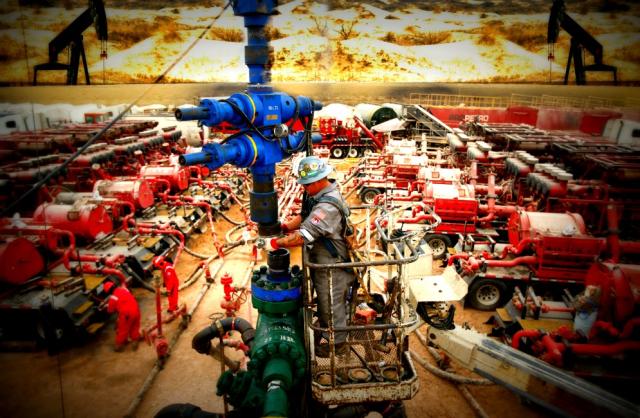
The oil and gas industry impatiently waits as Permian Basin sand mining—set to upset the proppant market apple cart—struggles to come up to speed. (Source: Hart Energy)
[Editor's note: A version of this story appears in the May 2018 edition of Oil and Gas Investor. Subscribe to the magazine here.]
Surviving spring sandstorms is a badge of honor for West Texans.
Sand remains a conversational topic this spring in West Texas, but in a context different than weather. The oil and gas industry impatiently waits as a nascent Permian Basin sand mining industry struggles to come up to speed.
When it does, Permian sand mines will collectively upset the proppant market apple cart, especially after winter weather bottlenecks curtailed delivery of traditional Northern White Sand from Wisconsin and Illinois into the Permian.
Mining firms have filed permits for 16 facilities and 60 million tons of output in the Permian Basin, though estimates expect less than 25 million tons of mostly 100-mesh sand to be delivered in 2018.
New capacity includes a 3.4-million-ton-per-year plant in Monahans, Texas, operated by Preferred Sands Inc. that came online in March 2018. Preferred, which is headquartered in Radnor, Pa., simultaneously commenced commercial operations for a 3-million-ton-per-year plant in Atascosa County, Texas, serving the Eagle Ford, and plans to initiate operations for a third in-basin plant in Oakwood, Okla., in 2018 to service the Midcontinent. By year-end, Preferred will feature 12.7 million tons per year in capacity, 75% tied to regional sand. The company generated $227 million in revenue in 2017.
Preferred amended its S-1 in March 2018 to reflect changes in the company’s financial structure and its transformation into a major regional provider of proppant, pending a future IPO. The company is known for creating the Navport database to develop insight into how proppant contributes to long-term production before selling the service in December 2016 to RS Energy.
“What we found, ironically, was that our number one selling product was not producing well and our worst selling resin product was producing unbelievably well,” Michael O'Neill Preferred’s CEO told Investor.
“On the issue of premium Northern White vs. regional brown sands, there was no significant difference in production over time,” O’Neill said.
Following the collapse in oil prices, O'Neill understood that E&Ps were disinclined to pay a premium without value. As a result, Preferred refined its business strategy to become a major supplier of low-cost regional sand and to rebrand its suite of award-winning engineered proppant as an agent in flowback control.
“The question is, how do you eliminate as much of the freight as possible, move it as close as you can, and then find a supplier who can supply you in more than one basin,” O'Neill said.
Preferred’s answer was to go all-in on in-basin sand where miners can supply product for $40 to $50 cheaper through eliminating rail transport and transloading infrastructure. A similar principle applies to engineered proppant with Preferred’s Monahans facility incorporating proprietary coating facilities onsite.
Stripping cost out of proppant provision is a trend among E&Ps, many of whom are self-sourcing sand. Previously, well stimulation firms accounted for 90% of Preferred’s sales. Today, the balance is split evenly between operators and service providers as E&Ps seek to reduce cost by unbundling services while broadening their supply chain.
Furthermore, social license is a growing issue for sand miners. Preferred takes a proactive stance in responding to local issues, including moving the entrance for its Eagle Ford mine to allay residential concerns, and participating in the evolving Texas Conservation Plan addressing habitat for the endangered dune sagebrush lizard. The latter enables Preferred to sell all of its West Texas sand on contractual basis.
A third transformational element involves delivery.
“We do the last mile for our customers in many cases,” O'Neill said, noting the company is agnostic on methodology.
“Some like boxes and some like silos, and we do both of those things. Few are focused on using software and technology to optimize delivery. We have over 40 trucking companies in our system—and that’s actually growing to 80—and we can coordinate between hundreds of trucks. At any given moment we know exactly where [trucks are] located. We can put out an order. They can respond through the software.”
With mining consolidations, facility divestitures, and rapidly developing Permian capacity, the sands are figuratively shifting beneath the feet of E&Ps and the national proppant mining industry.
Richard Mason can be reached at rmason@hartenergy.com.
Recommended Reading
Devon, BPX to End Legacy Eagle Ford JV After 15 Years
2025-02-18 - The move to dissolve the Devon-BPX joint venture ends a 15-year drilling partnership originally structured by Petrohawk and GeoSouthern, early trailblazers in the Eagle Ford Shale.
PE Firm Voyager to Merge Haynesville OFS Firm with Permian’s Tejas
2025-03-17 - Private equity firm Voyager Interests’ Haynesville Shale portfolio company VooDoo Energy Services will merge with Tejas Completion Services as part of a transaction backing Tejas, Voyager said.
E&Ps Pivot from the Pricey Permian
2025-02-01 - SM Energy, Ovintiv and Devon Energy were rumored to be hunting for Permian M&A—but they ultimately inked deals in cheaper basins. Experts say it’s a trend to watch as producers shrug off high Permian prices for runway in the Williston, Eagle Ford, the Uinta and the Montney.
Sitio Fights for its Place Atop the M&R Sector
2025-04-02 - The minerals and royalties space is primed for massive growth and consolidation with Sitio aiming for the front of the pack.
Ring May Drill—or Sell—Barnett, Devonian Assets in Eastern Permian
2025-03-07 - Ring Energy could look to drill—or sell—Barnett and Devonian horizontal locations on the eastern side of the Permian’s Central Basin Platform. Major E&Ps are testing and tinkering on Barnett well designs nearby.
Comments
Add new comment
This conversation is moderated according to Hart Energy community rules. Please read the rules before joining the discussion. If you’re experiencing any technical problems, please contact our customer care team.





